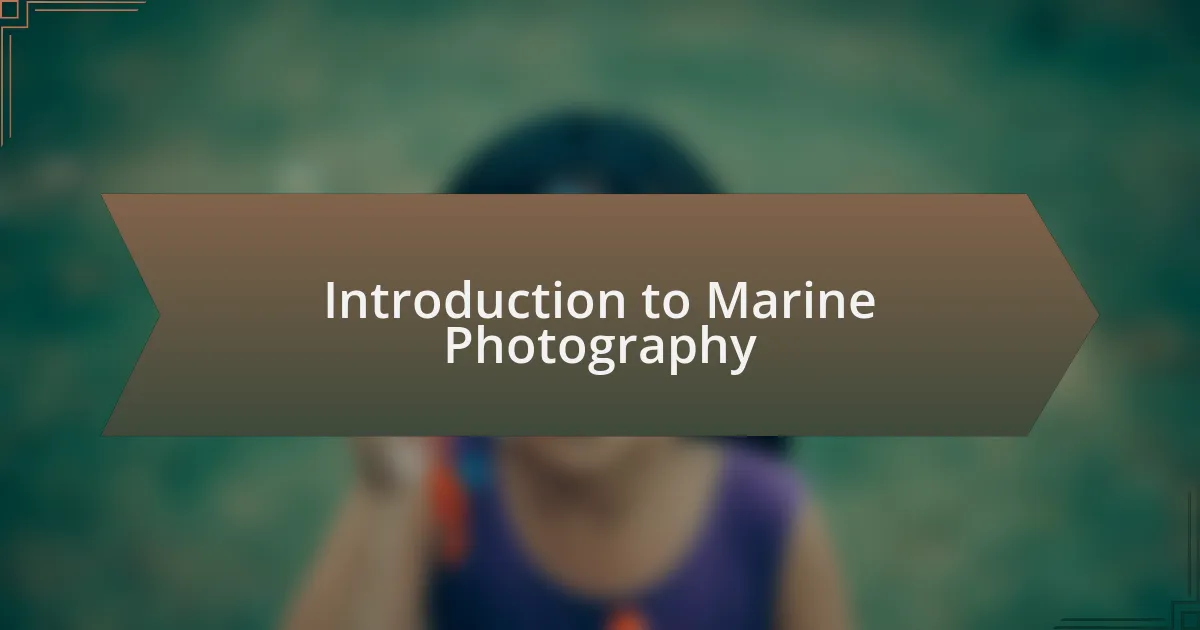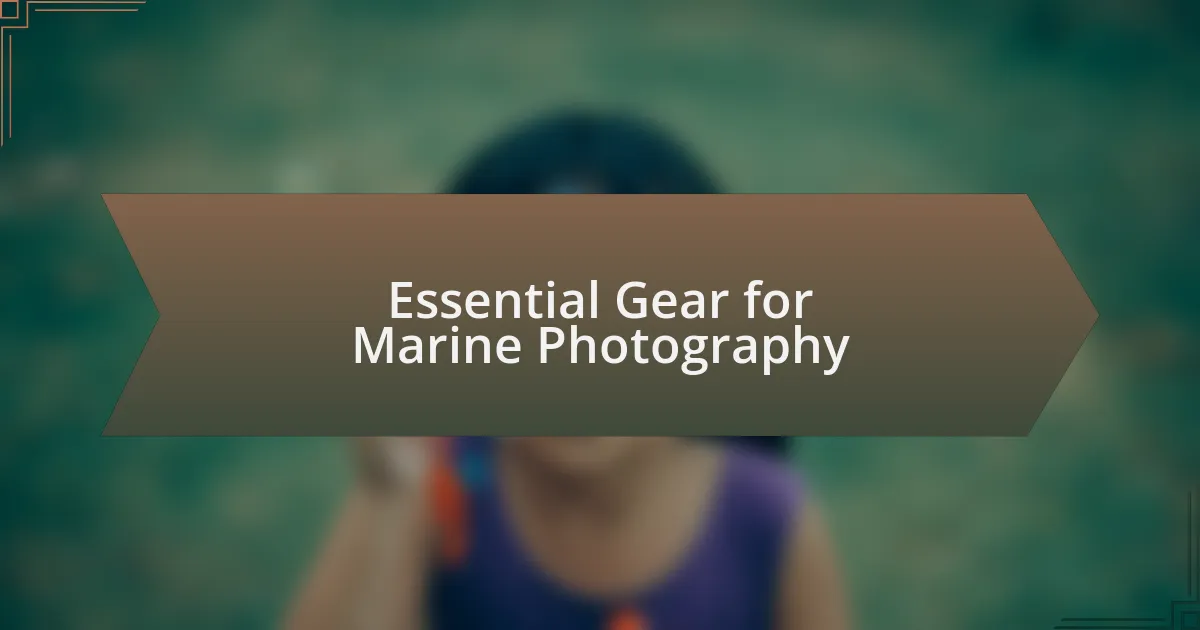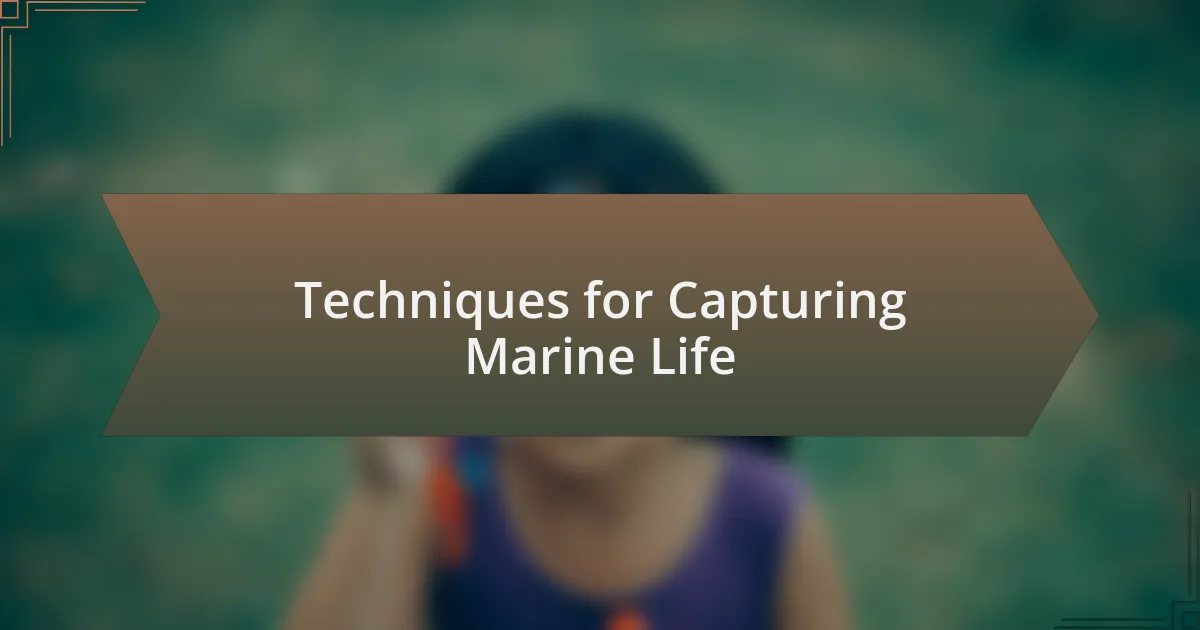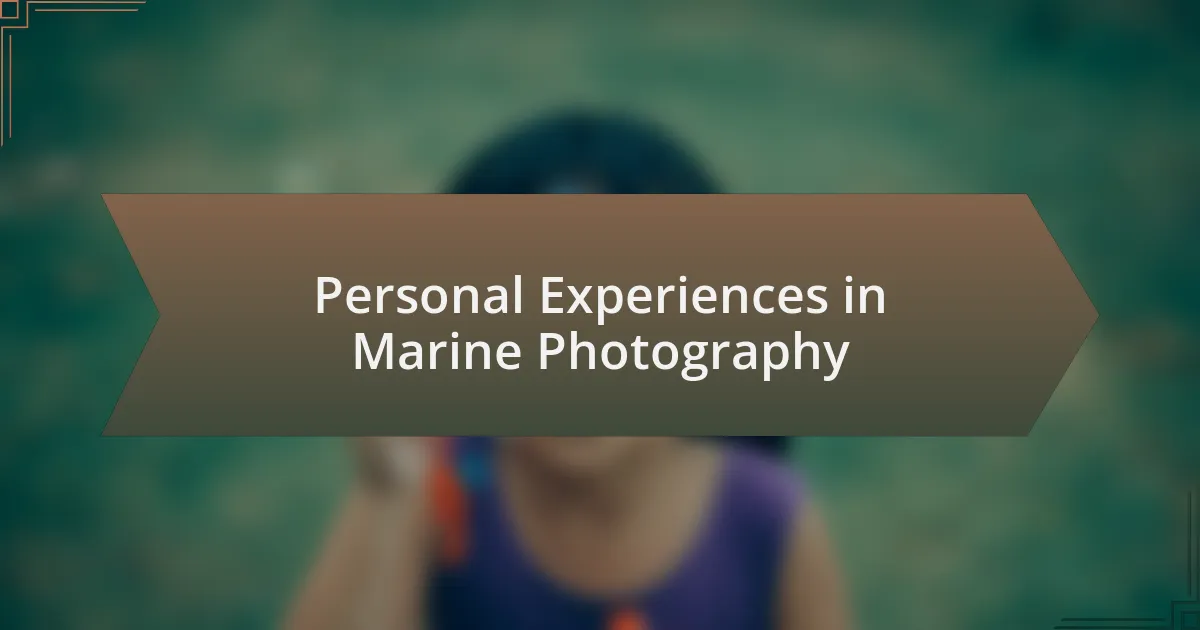Key takeaways:
- Marine photography combines technical skill and respect for underwater ecosystems, telling unique stories through each shot.
- Patience and understanding lighting are crucial for capturing the beauty of marine life, with techniques like backlighting and using wide-angle lenses enhancing the imagery.
- Engaging with the marine community enriches the experience, fostering camaraderie and shared learning among photographers.
- Choosing the right locations and times for dives, such as coral reefs and late afternoon, significantly impacts the quality and mood of photographs.

Introduction to Marine Photography
Diving into marine photography is like stepping into a vibrant world filled with life and color. I still remember my first underwater shoot, surrounded by schools of fish shimmering like jewels. It struck me how capturing their beauty requires not just skill, but a deep respect for the underwater environment.
The essence of marine photography lies in understanding the delicate balance of ecosystems and the creatures that inhabit them. Have you ever considered how each click of the shutter is a chance to tell a story? I find that each photograph reveals something new about the ocean, whether it’s the intricate patterns on a fish or the soft sway of kelp in the currents.
As you navigate this fascinating discipline, you’ll discover that patience is just as crucial as your technical skills. I’ve learned that waiting quietly can yield breathtaking moments, like when a shy sea turtle finally surfaces. The thrill of capturing these fleeting instances fuels my passion for marine photography—even on days when conditions aren’t perfect, there’s always something beautiful waiting to be revealed.

Benefits of Marine Photography
Marine photography offers remarkable benefits that extend beyond simply capturing stunning images. For me, each dive is an immersive escape into tranquility, where I can lose myself in the rhythm of gentle waves. Have you ever felt that kind of peace? The ocean has a unique way of quieting the mind, allowing room for reflection and creativity.
Additionally, through my lens, I’ve gained a profound appreciation for marine ecosystems. I recall a moment when I filmed a vibrant coral reef teeming with life, and it reminded me of the fragile interconnections that exist. That experience underscored the urgency of marine conservation, which becomes a driving force in my work. Isn’t it incredible how photography can raise awareness and foster a sense of responsibility for our oceans?
Finally, I’ve found that marine photography cultivates a community of passionate individuals. There’s a sense of camaraderie among those who share this interest, whether during shared dives or online forums. I often engage in discussions with fellow photographers, exchanging tips on techniques or locations. Doesn’t that make capturing moments in the ocean even more rewarding? Sharing insights enhances the journey for everyone involved, deepening our connection to the underwater world.

Essential Gear for Marine Photography
When it comes to marine photography, having the right gear is essential for capturing the underwater wonders I love. My go-to is a sturdy waterproof camera housing. The first time I used it, the clarity of the images blew me away. I remember swimming alongside a school of fish, knowing that my camera was secure while I focused on the moment. It felt exhilarating to actually see the results.
A wide-angle lens is another critical piece of equipment for those breathtaking panoramic shots. I discovered this the hard way during a dive where the shimmering seascape stretched endlessly before me. With a standard lens, I struggled to encompass the entire scene. Since then, I prioritize wide-angle lenses, allowing me to create images that pull viewers into the vastness of the ocean. Have you ever wished to convey a sense of space and depth in your photos? This gear choice makes all the difference.
Additionally, proper lighting gear, like underwater strobes or video lights, can elevate your marine shots. I recall an evening dive where the fading light transformed the underwater world into a realm of shadows and vibrant colors. The strobe I brought allowed me to illuminate a beautiful seahorse hidden among the corals, capturing a moment that would have been lost without it. It’s incredible how the right tools can unlock the potential in every scene!

Choosing the Right Locations
Choosing the right location for marine photography can truly transform your experience. I often find myself drawn to areas where marine life is abundant, like coral reefs, as they offer vibrant colors and fascinating behaviors. One memorable outing was at a reef where I stumbled upon a giant sea turtle resting on the ocean floor. I could hardly believe my luck! The location made all the difference in capturing such an extraordinary moment.
Understanding the time of day and tides can significantly impact your shots, too. Late afternoon dives, in particular, have a way of filling the water with golden light. I remember one day when I arrived just as the sun dipped low, casting enchanting rays that danced through the water. It was a pure stroke of serendipity that turned ordinary shots into something magical. Have you ever noticed how light changes the mood of your photos? Choosing the right moment can elevate your work beyond expectations.
Exploring less crowded, off-the-beaten-path locations can also lead to unexpected treasures. During an adventure to a secluded coastline, I discovered an underwater cave teeming with unique marine life, away from the typical dive spots. The isolation allowed me to capture serene scenes without the usual disturbances. There’s something blissful about photographing in tranquility, isn’t there? Those secluded spaces often tell stories that busy locations simply cannot.

Techniques for Capturing Marine Life
When it comes to techniques for capturing marine life, I’ve found that patience is key. I remember hovering in the water, completely still, watching a school of clownfish dart in and out of their anemone. It was a test of endurance, but the reward was an intimate glimpse into their world that I managed to capture on camera. Have you ever realized how stillness can reveal so much more than action?
Another technique I swear by is using natural light wisely. On one particular trip, I experimented with backlighting while photographing jellyfish. The sun filtering through their translucent bodies created an ethereal glow that transformed them into living artworks. It made me wonder, how many times do we overlook the beauty of simple lighting? By adjusting my position, I found that even familiar subjects can take on a fresh perspective.
Finally, employing wide-angle lenses can completely change your approach to marine photography. I’ll never forget the time I used a wide-angle lens to capture a sweeping view of a reef with a diver in the frame. It conveyed the scale and beauty of the underwater environment in a way that felt monumental. Has that ever happened to you, where a shift in equipment opened up new possibilities? Those expansive shots help convey the vastness of the ocean, making the viewer feel part of the adventure.

Personal Experiences in Marine Photography
As I ventured deeper into marine photography, I quickly learned how pivotal the connection with marine life is. I once encountered a curious sea turtle that swam right up to me, seemingly inviting me into its world. That brief moment felt surreal, and capturing it on camera wasn’t just about the image—it was about the experience of truly seeing and being seen in that vast underwater world. Have you ever felt that deep connection with wildlife?
Another unforgettable experience happened during a night dive when bioluminescent plankton shimmered like stars in the water. I remember being completely awestruck, feeling as if I had stumbled into a magical realm. Using long exposure to capture those ethereal glows made my heart race with excitement. It’s moments like these that remind me why I am so passionate about marine photography—each click of the shutter feels like sharing a piece of that magic with others. Have you ever captured a moment that just took your breath away?
I’ve also faced challenges that shaped my growth as a marine photographer. During a dive, I struggled to photograph a fast-moving school of fish darting around a coral reef. My first attempts were a blur of color and chaos. With practice, I learned to anticipate their movements, and one day, I finally nailed a shot that conveyed their frenetic energy. This taught me that perseverance is as crucial as technical skill. Have you ever pushed through challenges to achieve something rewarding?